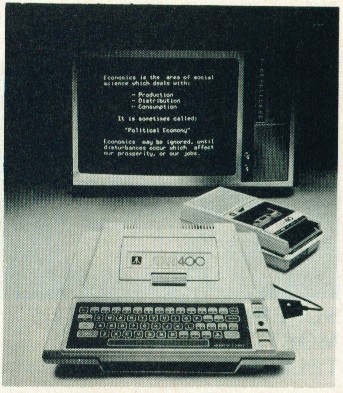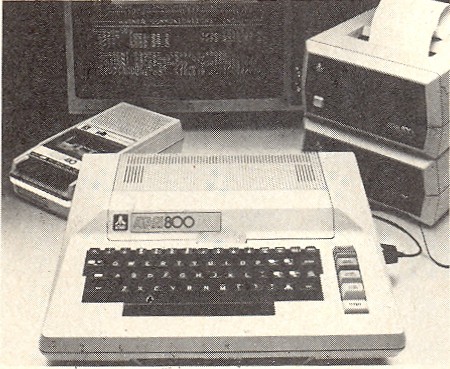
The Atari 800, 810 disk drive, and 820 printer debut at the January 1979 Winter CES in Las Vegas
Creative Computing, vol 5, no 4, April 1979, p. 16

The Atari 800, 810 disk drive, and 820 printer debut at the January 1979 Winter CES in Las Vegas
Atari, the "Video Game People," have come out with two personal computers; the model 400 for home use and the model 800 for business applications. The 400 has a touch keyboard, cassette interface and some fantastic educational, entertainment and home applications software. The 800 has a standard ASCII keybaord, cassette, floppy and printer interfaces with business software packages (touch-typing trainer, payroll, charge account management...just to name a few). Both systems are 6502-based, use voice prompts via the 2nd channel of the cassette and come with BASIC. Atari Inc., 1265 Borregas Ave., PO Box 9027, Sunnyvale, CA 94086.
Creative Computing, vol 5, no 4, April 1979, pp. 62-63

The first publicity photo of the Atari 400, shown with 410 program recorder
Atari Inc., a division of Warner Communications Inc. and the nation's leading manufacturer of sophisticated computer-controlled video games, is entering the personal-home computer industry.
Atari will shortly introduce two new personal computer systems that have been developed for use by both those people with no prior computer experience and those with experience and sophisticated needs and requirements.
The Atari line of personal computers will have a substantial library of computer software consisting of applications such as: Personal Financial Management; Income Tax Preparation; Household and Office Record Keeping; Computer Aided Instruction in over 20 subject areas, including Math, English, History, Literature, Economics, Psychology, Auto Mechanics and many others.
Both the ATARI-400™ System and the ATARI-800™ System are programmable by the user in the most popular language for personal computers, BASIC. Other programming languages will become available on preprogrammed solid state cartridges.
The general purpose ATARI-400™ System allows an easy transition from video games to a full-fledged personal computer. The System features a 57 key monopanel keyboard, single cartridge slot for solid state programs of up to 8,000 bytes of memory, cassette recorder capability and an internal audio speaker.
The specialized ATARI-800™ System features dual cartridge capability, user expandable random access memory up to 48,000 bytes, a series of optional peripheral devices including a high speed floppy disc for mass data storage and retrieval, and a 40-column printer utilizing standard paper. The versatile and expandable nature of the ATARI-800™ System allows the consumer to select components tailored to their specialized needs. Other peripheral devices, including telecommunications capabilities are currently under devleopment. Atari, Inc., 75 Rockefeller Plaza, New York NY 10019.
Creative Computing, vol 5, no 8, August 1979, p. 66

Distant view of the Atari computers booth at the 4th West Coast Computer Faire, San Francisco, May 11-13, 1979
View of one aisle of downstairs exhibit area. Atari booth (to the left) was perpetually mobbed.
Creative Computing, vol 5, no 8, August 1979, p. 26

The first publicity photo of the Atari 800, shown with 410 program recorder, 820 printer, and 810 disk drive
At the Summer CES in Chicago, June 1979...
Atari continued to show the Atari 400 ($550) and Atari 800 ($1000) on which we've previously reported (April 1979, pp. 16 and 62). However, they did announce a very extensive line of educational tape cassette programs, seventeen in all on subjects ranging from history to sociology, accounting to physics, writing to auto mechanics and psychology to economics. Retail $40 each. We find these releases especially impressive given Atari's heritage as a game company.
Creative Computing, vol 5, no 8, August 1979, p. 58

Peter Rosenthal, marketing manager of personal computers for Atari
Scans by Michael Current, December 2006-January 2007